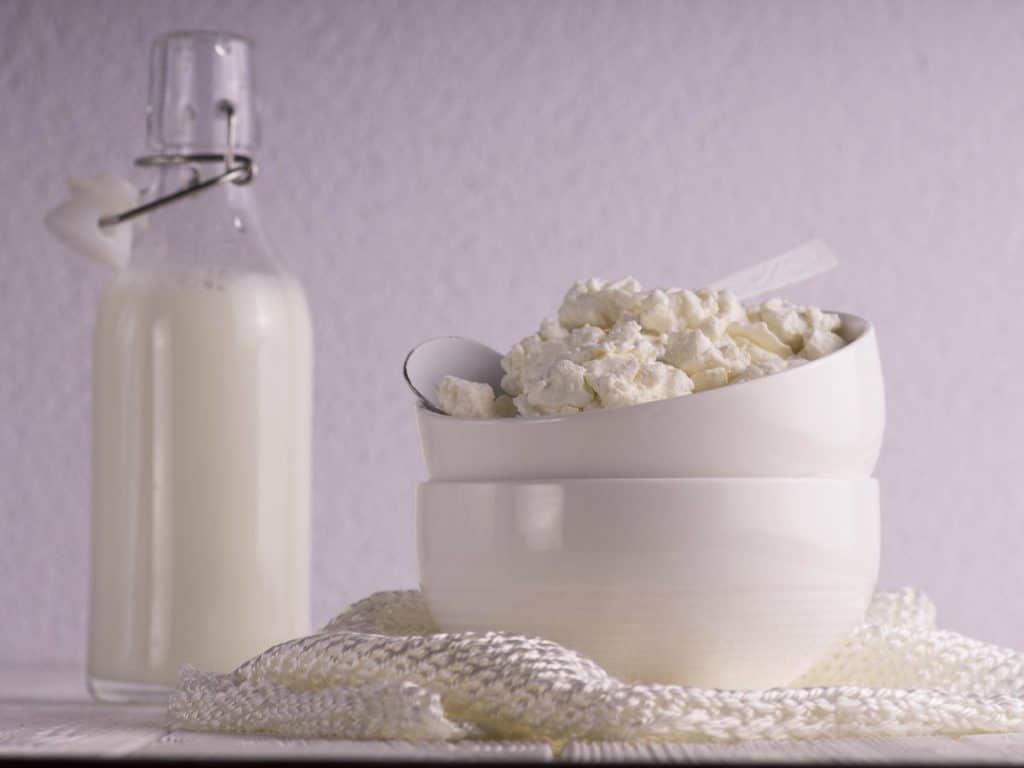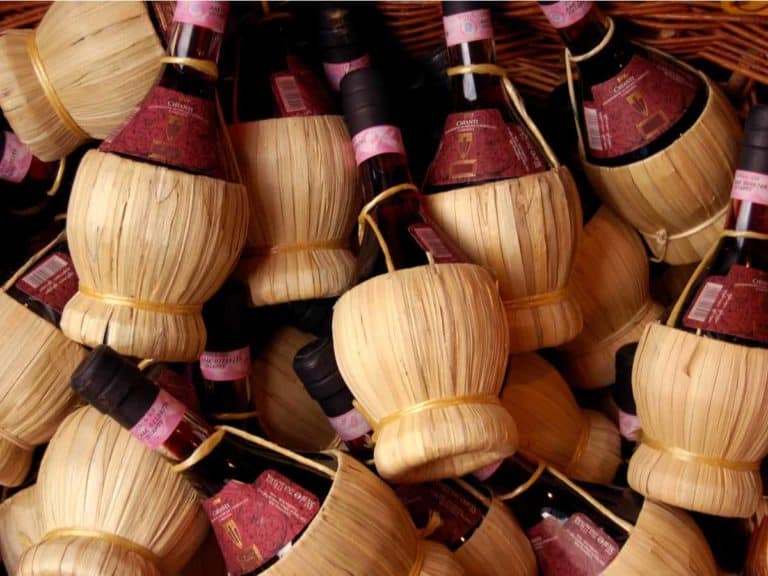Why Does Milk Curdle in the Refrigerator?
It is said that milk should be refrigerated to keep it from going bad. And this is why it can be frustrating to see that the milk you just added to your coffee has lumps even if it’s been in the fridge all the while.
Milk curdles in the refrigerator as it naturally contains some cold-tolerant bacteria. Because of these microbes, milk can still spoil and curdle even if refrigerated. In some instances, curdling happens much faster in the fridge due to exposure of milk to bacteria prior to refrigeration.
If nothing can ruin the start of your day more than accidentally consuming lumpy and sour milk, read on!

Best Temperature for Milk in the Refrigerator
Experts agree that milk should be stored in the refrigerator at 40°F (4.44°C) or lower. Seeing to it that the temperature in the fridge is ideal can help extend the shelf life of milk to several days. What’s more, serving milk at the recommended temperature can help make milk taste its best.
It’s not enough that you store milk in a refrigerator whose temperature is perfect for keeping it in tip-top shape. It’s also a must that you stash milk in the right spot in the fridge.
The best place for milk in the refrigerator is the bottom shelf, which is the coldest spot. That’s because hot air rises and cold air sinks. But don’t just place milk on the bottom shelf — it’s a good idea to place milk at the back part of the bottom shelf. That’s because it’s the farthest spot from the door and refrigerator light, too.
Milk in the fridge can last anywhere for four to seven days if refrigerated properly.
Best Container to Store Milk in the Fridge
The best container to store milk in the refrigerator is one that’s airtight and made out of either glass or plastic. Each material comes with benefits. For instance, glass helps to keep milk stay cooler. On the other hand, plastic, especially opaque or colored, helps to protect milk from light.
Airtight — this is the most important thing you should bear in mind when choosing a container for milk.
It goes without saying that the container should be refrigerator-safe. Otherwise, milk could be compromised as the container in which it’s stored is unable to withstand the environment inside the refrigerator.
When choosing between a glass and plastic container, consider how you incorporate milk into your everyday life. Do you take the container out of the refrigerator for a while? Glass is great since it helps to keep milk cool longer. Are there lots of windows in your kitchen? Opaque or colored plastic is perfect as it helps to shield milk from light.
How To Keep Milk Fresh Longer Without a Fridge
To keep milk fresh without a refrigerator, store it in a cooler whose temperature is kept at 40°F (4.44°C) or lower all the time. Outside a cooler, place milk in a cool spot, away from light. Milk should not be stored at room temperature for more than two hours — or one hour during a hot day.
It’s no secret that milk tends to go bad in no time, which is why it should be stored in the refrigerator at all costs. Of course, the best way to keep it in the fridge is by following the recommendations earlier.
But just in case a refrigerator is not available, milk can be kept in a cooler.
Unfortunately, milk can stay fresh in a cooler for two to three days only. And also, you will have to make sure that the temperature in the cooler is high enough to slow down the proliferation of bacteria in milk. As soon as a fridge becomes available, immediately transfer milk in a cooler into it.
Milk That’s Curdled But Not Sour
Milk that is curdled but not sour is probably the result of intentional curdling or the addition of something acidic. It may also be due to heating milk. In some instances, milk may form a thin skin on its surface, which tends to happen when it is heated. It doesn’t mean that milk has gone bad.
Besides your eyes, you can also use your nose and mouth to tell whether or not milk has gone bad. You can rest assured that milk has to be disposed of if it’s not only lumpy but also sour taste- and smell-wise.
However, it’s not all the time that curdled milk is sour and thus spoiled.
There are instances in which curdles are allowed to form in order to turn milk into another dairy product, such as cheese or yogurt. Just about anything acidic, such as vinegar or lemon juice, is added to milk for intentional curdling. Without any sour taste or smell, milk that is allowed to curdle deliberately is fit for human consumption.
Is Curdled Milk Safe to Eat?
Curdled milk is safe to eat provided that it doesn’t taste and smell sour. As a matter of fact, there are many dairy products that are made by allowing milk to curdle. However, if milk curdling is not intentional and it already smells horrible, it is a much better idea to get rid of it instead.
Everyone knows what milk is supposed to look like. And this is why if it no longer looks the way it’s supposed to look, make sure that you examine milk carefully before deciding to consume it despite its appearance.
If milk has gone through intentional curdling, then curdled milk is just the result of accomplishing the mission.
It’s a different story if the lumpy appearance of milk is accompanied by an unmistakable sour smell. It could be very faint in some instances, especially if milk has just started curdling as a result of going bad. There are times when the sour smell is very strong, which usually comes from severely curdled milk as a result of having gone bad for a while already.
Is Curdled Milk Safe to Cook With?
Curdled milk that tastes and smells sour isn’t safe to cook with. It’s not uncommon for milk used for cooking to curdle, which can stem from exposure to high temperatures, such as when simmering or boiling it. Curdled milk as a result of cooking is safe to eat, but it isn’t particularly appetizing.
Whether fresh from the supermarket or stored in the refrigerator for a while, see to it that you thoroughly inspect milk before using it as a cooking ingredient.
Accidentally adding spoiled milk to the rest of the ingredients requires you to start from scratch.
There is no need to worry if the recipe requires the use of milk that’s curdled intentionally, such as adding a teaspoon of vinegar, lemon juice or any other acidic ingredient beforehand. In some instances, milk might curdle when used for cooking. Milk has the penchant to curdle when exposed to heat, so keep stirring.
Why Does Milk Curdle in Coffee?
There are a couple of reasons why milk curdles in coffee. First, coffee is acidic. Milk curdles when it comes into contact with something that’s acidic, like vinegar and lemon juice. Second, coffee is hot. Heat can cause milk to curdle, which is why it’s less likely to happen if coffee is cold.
Some people love adding some milk to their coffee. That’s because it allows their favorite beverage to have a creamier taste and a richer texture. A little milk also helps reduce the bitterness and acidity of coffee.
However, milk may curdle in coffee, which can make the drink a little uninviting rather than more enticing.
In order to keep the odds of milk curdling when added to coffee low, there are two things you may give a try.
Related Article: Coffee With Milk vs Coffee With Water
First, opt for light-blend coffee to keep the acidity (as well as bitterness) levels low.
Second, let piping hot coffee cool a bit — not only will this keep milk from curdling but also save your mouth from being scalded.
What to Do With Curdled Milk?
Curdled milk that doesn’t taste and smell sour may still be used for cooking. Exposure to heat will kill any present bacteria, thus keeping the risk of food poisoning at bay. Sometimes, milk curdles as a result of aging. It’s not all the time that the presence of curdles is an indicator of spoilage.
Believe it or not, professional bakers swear that many baked treats taste better when curdled milk is used.
Milk that has curdled due to age and not exposure to bacteria at room temperature can be used as a substitute for staple baking ingredients such as cream and buttermilk. Without the need to throw away curdled milk as well as use expensive ingredients, you can whip up delectable baked goodies for less!
You can use intentionally curdled milk for making homemade cheese. There are various types of cheese made by causing milk to curdle. Some examples are cottage cheese, cream cheese and queso blanco.
Just Before You Store or Use Milk
The more spoiled milk is, the worse the digestive issues are if accidentally consumed. Make sure that you keep your eyes peeled and your nose sharp before you pour that milk into your cup of coffee or bowl of cereals. And to keep unnecessary frustrations at bay, see to it that you store milk properly.
Related Questions
Can you store milk in the freezer?
It’s possible to store milk in the freezer. When properly done, milk can stay fresh in the freezer for up to six long months. However, it’s generally a good idea to consume milk within one month of freezing it. Remember to store milk in a freezer-safe container before keeping it in the freezer.
Can you reverse milk curdling?
When milk goes bad, its components separate into curd and whey. The curd is the solid part, while the whey is the liquid part. Unfortunately, the curdling of milk is irreversible. Once the chemical change necessary to separate it into curd and whey happens, milk cannot be brought back into being milk.
Read Also: Why Does Lactose-Free Milk Taste Sweet?





